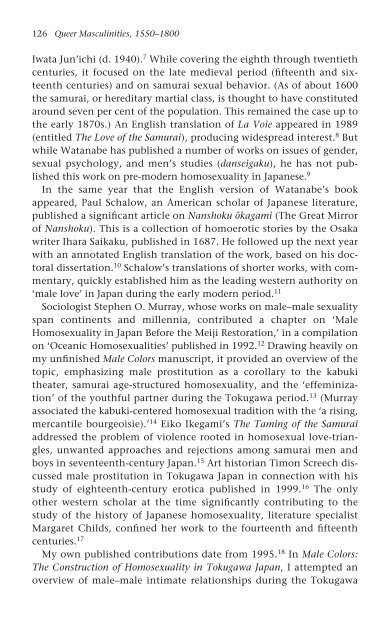queer masculinities
queer masculinities
queer masculinities
You also want an ePaper? Increase the reach of your titles
YUMPU automatically turns print PDFs into web optimized ePapers that Google loves.
126 Queer Masculinities, 1550–1800<br />
Iwata Jun’ichi (d. 1940). 7 While covering the eighth through twentieth<br />
centuries, it focused on the late medieval period (fifteenth and sixteenth<br />
centuries) and on samurai sexual behavior. (As of about 1600<br />
the samurai, or hereditary martial class, is thought to have constituted<br />
around seven per cent of the population. This remained the case up to<br />
the early 1870s.) An English translation of La Voie appeared in 1989<br />
(entitled The Love of the Samurai), producing widespread interest. 8 But<br />
while Watanabe has published a number of works on issues of gender,<br />
sexual psychology, and men’s studies (danseigaku), he has not published<br />
this work on pre-modern homosexuality in Japanese. 9<br />
In the same year that the English version of Watanabe’s book<br />
appeared, Paul Schalow, an American scholar of Japanese literature,<br />
published a significant article on Nanshoku ôkagami (The Great Mirror<br />
of Nanshoku). This is a collection of homoerotic stories by the Osaka<br />
writer Ihara Saikaku, published in 1687. He followed up the next year<br />
with an annotated English translation of the work, based on his doctoral<br />
dissertation. 10 Schalow’s translations of shorter works, with commentary,<br />
quickly established him as the leading western authority on<br />
‘male love’ in Japan during the early modern period. 11<br />
Sociologist Stephen O. Murray, whose works on male–male sexuality<br />
span continents and millennia, contributed a chapter on ‘Male<br />
Homosexuality in Japan Before the Meiji Restoration,’ in a compilation<br />
on ‘Oceanic Homosexualities’ published in 1992. 12 Drawing heavily on<br />
my unfinished Male Colors manuscript, it provided an overview of the<br />
topic, emphasizing male prostitution as a corollary to the kabuki<br />
theater, samurai age-structured homosexuality, and the ‘effeminization’<br />
of the youthful partner during the Tokugawa period. 13 (Murray<br />
associated the kabuki-centered homosexual tradition with the ‘a rising,<br />
mercantile bourgeoisie).’ 14 Eiko Ikegami’s The Taming of the Samurai<br />
addressed the problem of violence rooted in homosexual love-triangles,<br />
unwanted approaches and rejections among samurai men and<br />
boys in seventeenth-century Japan. 15 Art historian Timon Screech discussed<br />
male prostitution in Tokugawa Japan in connection with his<br />
study of eighteenth-century erotica published in 1999. 16 The only<br />
other western scholar at the time significantly contributing to the<br />
study of the history of Japanese homosexuality, literature specialist<br />
Margaret Childs, confined her work to the fourteenth and fifteenth<br />
centuries. 17<br />
My own published contributions date from 1995. 18 In Male Colors:<br />
The Construction of Homosexuality in Tokugawa Japan, I attempted an<br />
overview of male–male intimate relationships during the Tokugawa


